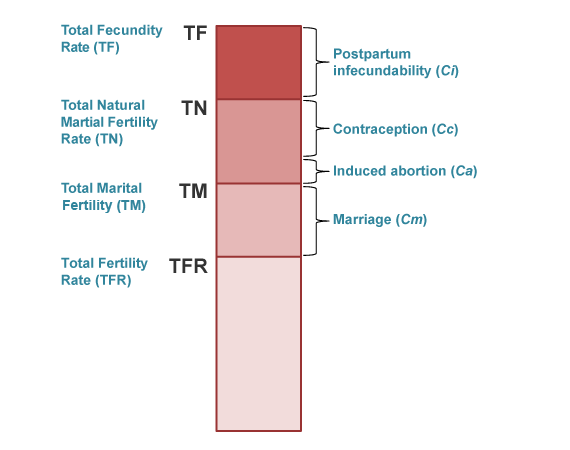Bongaarts’ aggregate model of the proximate determinants of fertility (cont.)
The relation of TFR and the inhibitors of fertility are expressed in the following equation.
TFR = TF × Cm × Ci × Ca × Cc
where:
TFR = total fertility rate TF = total fecundity rate Cm = index of marriage Ci = index of postpartum infecundability Ca = index of abortion Cc = index of contraception
Figure 2: Relationships between the fertility-inhibiting effects of the proximate determinants and various measures of fertility

Source: Bongaarts (1982)
TFR = Total Fertility Rate
Total number of births a woman would have if she lived from age 15 to age 50 and experienced a set of age-specific fertility rates (ASFRs) of the period of interest. In Bongaarts’ model, TFR excludes children born outside marriage or sexual union.
If the fertility-inhibiting effect of delayed marriage and marital disruption is removed without other changes in fertility behaviour, fertility will increase to a level TM, the Total Marital Fertility Rate.
TM = Total Marital Fertility Rate
Total number of births a woman would have at the end of the reproductive years if she lived from age 15 to age 50, experienced a set of age-specific fertility rates (ASFRs) of the period of interest and remained married or in sexual union during the entire reproductive period.
If all practice of contraception and induced abortion is also eliminated, fertility will rise further to a level TN, the Total Natural Fertility Rate.
TN = Total Natural Fertility Rate
Total number of births a woman would have if she lived from age 15 to age 50, experienced age-specific fertility rates (ASFRs) of the period of interest, remained married or in sexual union during the entire reproductive period, and uses no contraception or induced abortion.
If all practice of breastfeeding and postpartum abstinence is removed, fertility will increase to its maximum level, TF, the Total Fecundity Rate.
TF = Total Fecundity Rate
TFR, TM and TN vary widely between populations, but TFs of most populations is regarded to fall within the range of 13-17 births per woman, with an average near 15 in this aggregate model. TF is relatively invariant because the three remaining proximate factors (natural fecundability, spontaneous intrauterine mortality and permanent sterility) which determine TF usually vary little between populations and cause only modest changes in fertility.